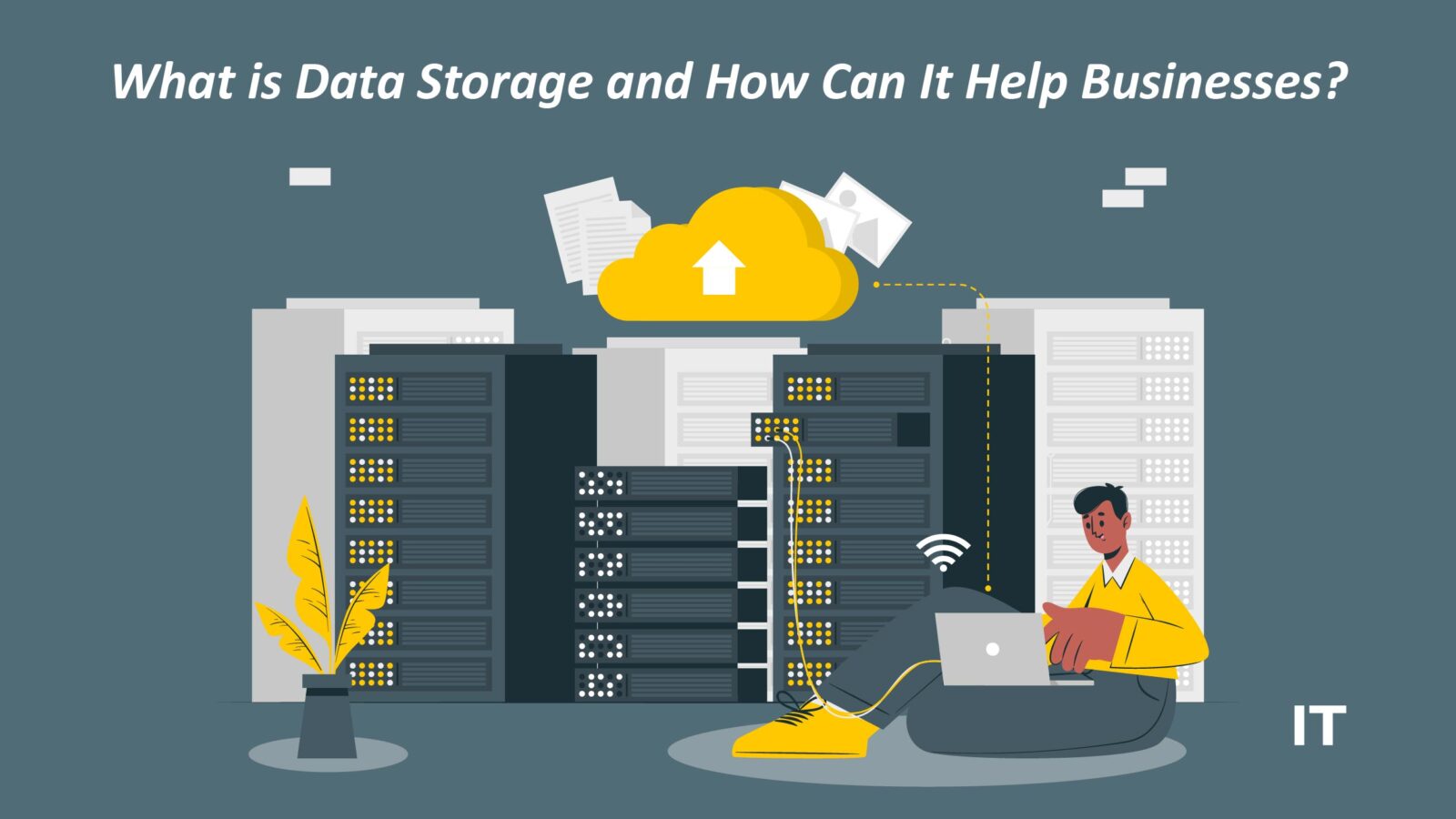In the digital age, the generation and accumulation of data have reached unprecedented levels. From personal information to business operations, data is the lifeblood of our modern society. Hence ensuring robust data storage security protocols is paramount in today’s digital landscape.
Data storage solutions offer a viable answer to the challenges posed by the exponential growth of data. These solutions provide efficient and secure ways to store, manage, and protect data. By utilizing advanced technologies and methodologies, data storage solutions address the limitations of traditional storage methods and provide a robust infrastructure for handling data at scale. Let’s delve in and learn more about it.
What is Data Storage?
Data storage refers to the process of storing, managing, and preserving digital data in various formats, including documents, files, images, videos, databases, and more. It involves storing data in such a way that it remains accessible and reliable over time, allowing for easy retrieval and manipulation when needed. Data storage solutions can range from physical devices like hard disk drives (HDDs), solid-state drives (SSDs), and tape drives to cloud-based storage services offered by providers like Amazon Web Services (AWS), Google Cloud Platform (GCP), and Microsoft Azure.
What are the Primary Concerns Related to Data Storage?
 When it comes to data storage, key concerns encompass:
When it comes to data storage, key concerns encompass:
Security: Safeguarding sensitive information is paramount. Organizations must ensure data remains protected from unauthorized access, breaches, and cyber threats through encryption, access controls, and physical security measures.
Scalability: With data volumes soaring, scalability becomes crucial. Solutions capable of handling large data loads and expanding seamlessly, like cloud computing, are favored for their flexibility and cost-effectiveness.
Data Protection: Preserving data integrity and accessibility is vital. Strategies to prevent loss, corruption, or alteration, such as data protection software and backup plans, are essential for maintaining data reliability.
Compliance: Adhering to industry regulations is imperative. Aligning storage practices with data privacy laws, retention requirements, and handling protocols mitigates legal and financial risks.
Also Read: What is Big Data Architecture? A Comprehensive Guide
Data Management: Effective storage entails efficient data management. This involves organizing data, implementing lifecycle strategies, and ensuring accessibility while addressing issues like duplication, quality, and governance.
Cost: Data storage expenses can be substantial. Balancing storage needs with cost considerations requires evaluating options like on-premises, cloud, or hybrid solutions to find the most economical approach.
Why Are Businesses Racing to Adopt Cloud Computing?
 Businesses can increase productivity by using cloud services. On cloud servers, businesses store and process customer data. With cloud-based software programs like Salesforce, Zoom, and Slack, countless teams collaborate remotely.
Businesses can increase productivity by using cloud services. On cloud servers, businesses store and process customer data. With cloud-based software programs like Salesforce, Zoom, and Slack, countless teams collaborate remotely.
So, it should not come as a surprise that the cloud computing sector is a multi-billion-dollar industry that continues to expand every year.
Wipro FullStride Cloud Services demonstrated a successfully implemented shift to digitally enhanced revenue and profitability in its global study of 1,300 C-Suite executives.
While SaaS providers reported the best margins, other businesses also saw significant growth. Finance executives, for instance, reported revenue growth of up to 15% and profitability growth of up to 4%.
Also, employees can work remotely and outside of usual business hours while collaborating on documents thanks to the cloud, which gives authorized users quick access to the most recent version of a file.
How Does Cloud Storage Work?
Large data centers are maintained by cloud service providers in numerous locations all over the world.
Customers who acquire cloud storage from a vendor hand over control of the majority of the data storage-related functions to the vendor, including security, capacity, storage servers, computing resources, data availability, and network delivery.
Using conventional storage protocols or application programming interfaces (APIs), customer applications can access the cloud data that is being stored there, or they can move their data to the cloud.
Depending on the type of storage being used, many cloud storage methods exist. Block storage, file storage, and object storage are the three basic categories:
Block storage
Large data volumes are divided into smaller parts, called blocks, by block storage. Each block is assigned a special identification number and put on a storage device in the system. Block storage offers the low latency needed by applications like databases and high-performance workloads because it is quick and effective.
File storage
File storage, which is frequently used with network-attached storage and personal computer storage systems, organizes data in a hierarchical system of files and folders (NAS). In a file storage system, data is kept in files, which are kept in folders.
The folders are organized using directories and subdirectories, which are also utilized to find files and data. Given that users are accustomed to and some applications demand this hierarchical structure, a cloud with file storage can facilitate data access and retrieval.
Object storage
Data is saved as objects in object storage, which is made up of three parts: metadata related to the data file, the data itself, and a special identifier.
An object storage protocol stores a file and any related metadata as a single object and gives it an identification (ID) number using the RESTful API.
When a user enters their ID into the system to receive content, the system assembles the content along with all of its authentication, security, and metadata. Metadata can be altered in object-based storage systems, which helps speed up data access and analysis. With object storage, data can be stored in its native format with massive scalability.
The majority of commercial cloud storage services employ substantial numbers of hard drive storage systems mounted on servers connected by a network architecture that resembles a mesh. Moreover, service providers have enhanced their virtual storage options, which are often composed of solid-state drives with high-performance layers (SSDs). In general, high-performance cloud storage performs best when the servers and programs that access the storage are themselves cloud-based.
Cloud Storage Trends: Temporarily Clearing Data Clutter
Not all data is created equally when it comes to storage. The data you use every day doesn’t require the same level of security or accessibility as a long-term backup, after all.
Hot cloud storage and cold cloud storage each play a significant role in how you might manage and keep your data, even though there isn’t an industry-wide definition for either one.
Hot Cloud Storage
Hot cloud storage is used to describe information that is often accessed and utilized, similar to files on your hard drive, necessitating quicker and more expensive technology. This might apply to files that are frequently accessed locally or those that are easily accessed online using a service like Google Drive.
Cold Cloud Storage
The converse is true for cold storage; this is information that you want to store but rarely need to access, likely off-site and on slower equipment. As a result, storing cold data is less expensive than storing hot data. Cold storage will be located off-site on a platform like Amazon Glacier, where it will be accessible whenever you need it.
Warm Cloud Storage
In between the two, warm data storage offers easy access to the data while taking less of a financial hit than hot storage data. Older versions of files saved on a NAS system may be needed less frequently because they are in warm storage.
Depending on your needs, you can choose which “temperature” of storage is optimal. The quicker you can access your files, the hotter the storage, but it has a greater one-time or long-term cost. Access is more constrained the colder the storage is, but it is far less expensive than hot or warm storage.
What Is Decentralized Cloud Storage?
Decentralized storage involves storing data among several computers, often known as nodes, as opposed to centralized storage solutions, which store data on multiple servers that are hosted in a centralized database. A decentralized peer-to-peer (P2P) network links each of these nodes together. Peer-to-peer networks like these were first seen in Napster and BitTorrent.
Similar to any centralized storage system, a decentralized storage system allows you to upload and retrieve files from the network whenever you need to. While downloading a file from a decentralized storage system, for example, different pieces of the file must first be downloaded from a P2P network before the entire file can be downloaded.
This is also how BitTorrent functions. Nevertheless, because any data you upload to a decentralized storage network will be encrypted by default, nodes in a decentralized storage system cannot read or modify your files. As a result, you are completely protected and have complete privacy, which means that your data is secure.Best Decentralized Cloud Storage in 2024
- IPFS + Filecoin
● Sia
● Storj
● Arcana
● Holo
For years, centralized cloud storage services dominated the data storage market, but more and more people are beginning to recognize the flaws in those services, including, among other things, privacy concerns with cloud storage, system errors, unfair pricing, vulnerabilities with cloud storage, and data mismanagement.
Decentralized cloud storage networks, on the other hand, are powered by the blockchain and provide a better, more affordable, and more secure method of storing data. It is just a matter of time before people and businesses alike cross the border to a more robust, expansive data storage system, given the rising daily demand for effective data storage.
Final Takeaway
Data storage serves as the cornerstone of modern information management, facilitating the organization, preservation, and accessibility of digital data across diverse industries and applications. As technology continues to evolve and data volumes proliferate, the importance of robust and scalable storage solutions becomes increasingly evident.

































